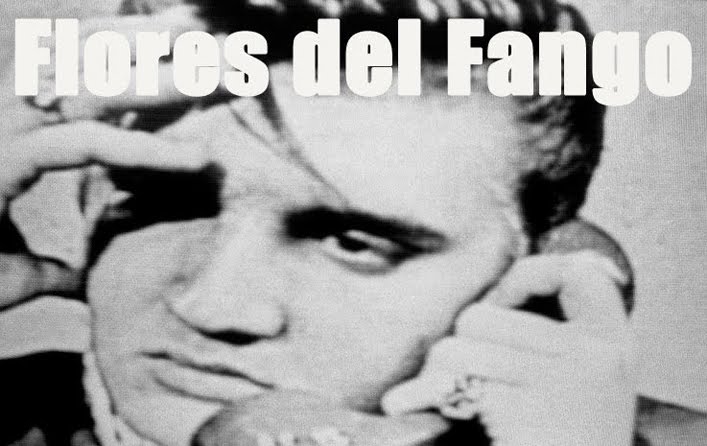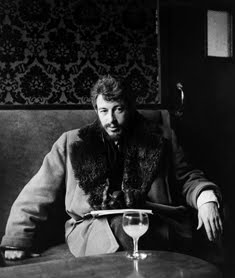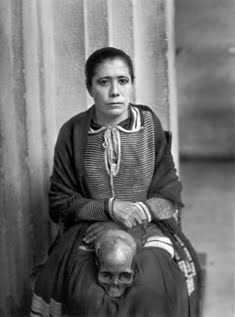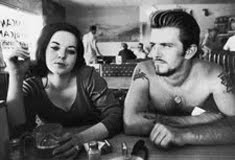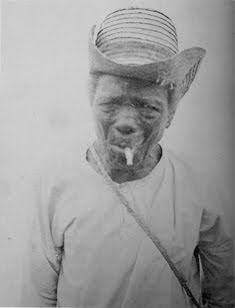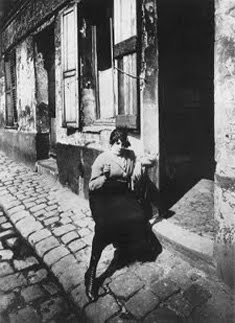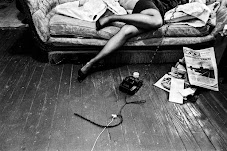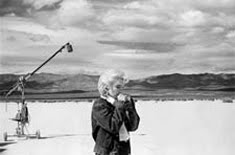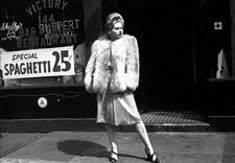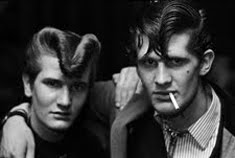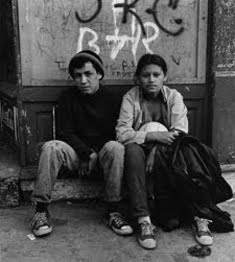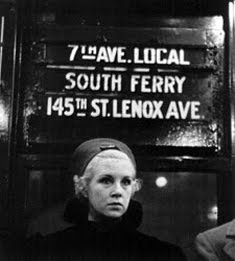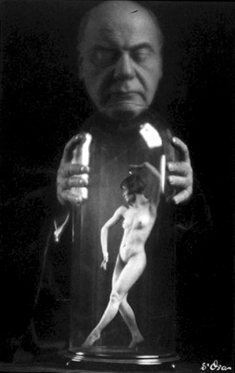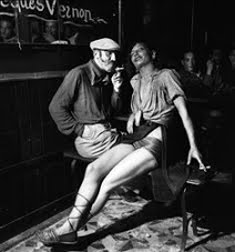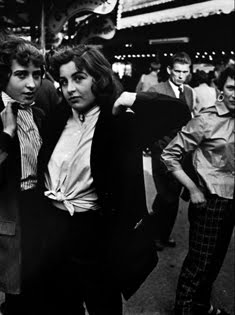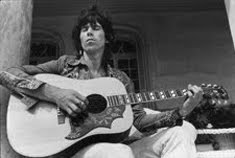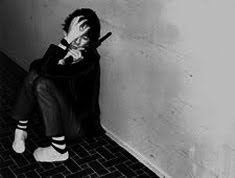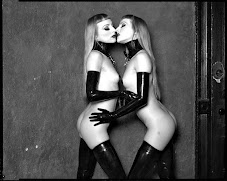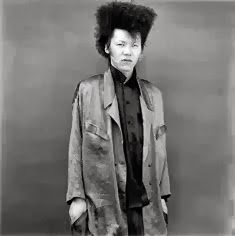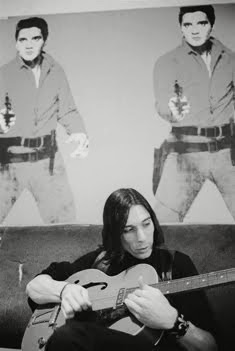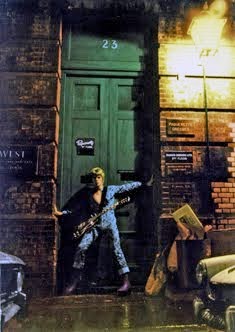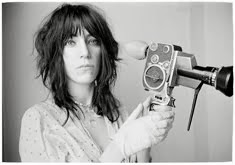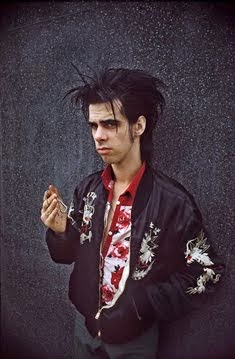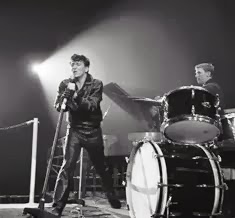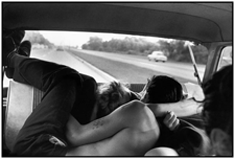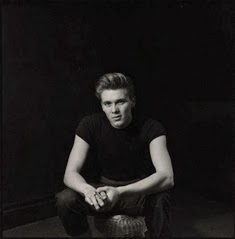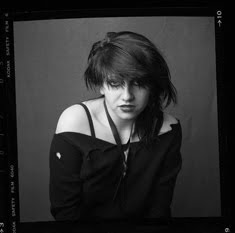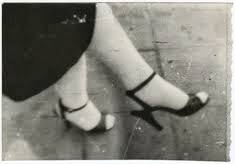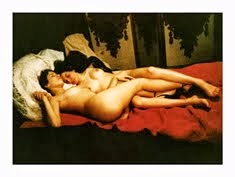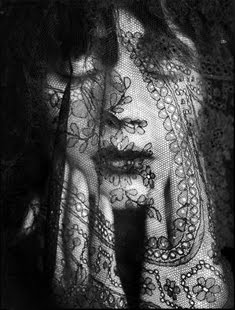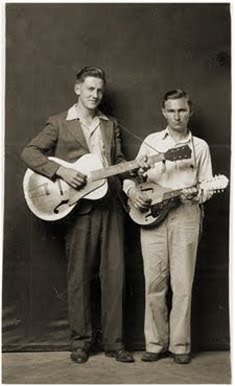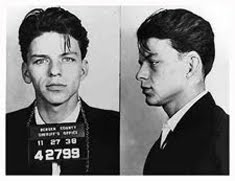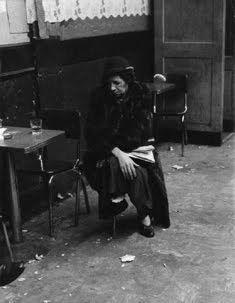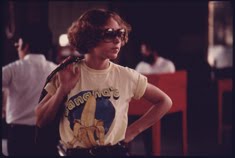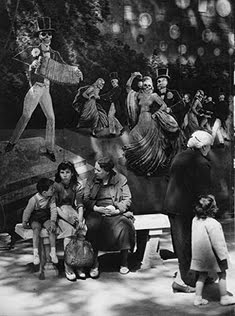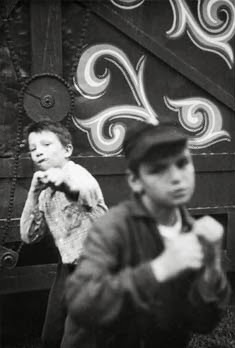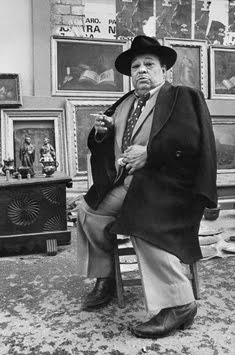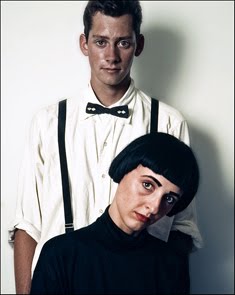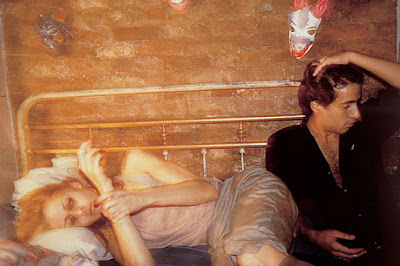
Greer y Robert en la cama, Nueva York, 1982: "Esta imagen, una de las favoritas de Goldin, es característica del estado de ánimo intensamente dramático que ofrecen muchas de las fotografías de su trabajo 'La Balada de la Dependiencia sexual'. Es especialmente conmovedora por el deseo no correspondido de Greer por Robert. La luz que rodea el cuerpo de ella le confiere una cualidad etérea, como de otro mundo y es una brillante evocación de la alienación entre los géneros. Greer, una artista del East Village, fue íntima de Goldin durante muchos años hasta su muerte prematura en Chicago en 1999. A ella está dedicada la obra de Goldin conocida como 'Retícula de Greer' que cuenta la historia de su corta vida y su transformación de hombre a mujer"/"This image, a favorite of Goldin, is characteristic of the intensely dramatic mood present in many of the photographs of her work 'The Ballad of Sexual Dependency'. It is especially poignant by the unrequited desire from Greer to Robert. The light around her body gives it an ethereal quality, like from another world, and is a brilliant evocation of alienation between the sexes. Greer, an East Village artist, was an intimate friend of Goldin for many years until her death in Chicago in 1999. Goldin's work known as 'Grid Greer' is dedicated to Greer, telling the story of her short life and her transformation from man to woman."


Nan y Brian en la cama, Nueva York, 1983: "Esta fotografía, que figura en la portada de la versión en libro de `La balada de la dependencia sexual', condensa la esencia poética de toda la serie. Capta a la perfección la relación íntima de dos existencias solitarias y la perpetua dialéctica de los sexos. Incluso el tratamiento de la luz potencia ese distanciamiento. La ambivalencia de la mirada de Goldin -deseosa pero al mismo tiempo temerosa de otra relación- es indicativa de lo que iba a pasar con su vida. Goldin, que la había tomado con un disparador a distancia, no supo lo premonitoria que era la fotografía hasta después del revelado."/"This photograph, which appears on the cover of the book version of 'The Ballad of Sexual Dependency', encapsulates the poetic essence of the entire series. It perfectly captures the intimate relationship of two lonely lives and the perpetual dialectic of sexes. Even the light treatment empowers that distance. The ambivalence of the look from Goldin -eager eyes but at the same time fearful of another relationship- is indicative of what would happen later. Goldin, who had taken it with a remote shooter, did not know what that how prescient this picture was until developing it."
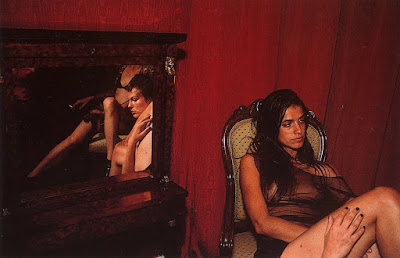

Misty y Jimmy Paulette en un taxi, Nueva York, 1991: "El compromiso político de Goldin con los derechos humanos la ha llevado a implicarse en iniciativas y manifestaciones en favor de la comunidad gay y de los enfermos de sida. Esta fotografía, que fue hecha camino del desfile gay de Nueva York de 1991, es una de las imágenes má reproducidas de Goldin. Pese al hecho de haber sido tomada en un ambiente de intimidad, la imagen ha aparecido en reclamos comerciales de todo tipo"/"Goldin's political commitment to human rights has had her involved in initiatives and events for the gay community and for AIDS patients. This photograph, which was made in the way to the gay parade in New York in 1991, is one of the most reproduced images of Goldin. Despite having been taken in an intimate setting, the image has appeared on commercials of any kind."

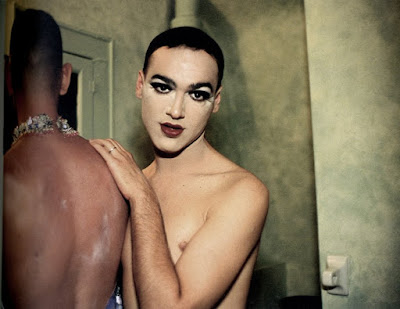
Jimmy Paulette y Taboo! en el cuarto de baño, Nueva York, 1991: "Jimmy Paulette, Taboo!, Cody, Misty, Guy y otras drag queens son el tema central de algunas de las fotografías más conocidas de Goldin, tomadas en Nueva York, París y Berlín entre 1990 y 1992. Esta instantánea en concreto, que apareció en la portada de 'El Otro Lado', es una de las más reproducidas y conocidas. Aunque representa tan solo una de las muchas vertientes de la obra de Goldin, la serie de las drag queens atrajo especialmente la atención del público."/"Jimmy Paulette, Taboo!, Cody, Misty, Guy and other drag queens are the focus of some of the best known Goldin's photographs, taken in New York, Paris and Berlin between 1990 and 1992. This particular instant, which appeared on the cover of 'The Other Side', is one of the most shown and well known. Although it represents only one of many aspects of the work of Goldin, the drag queens series attracted special attention of the public."

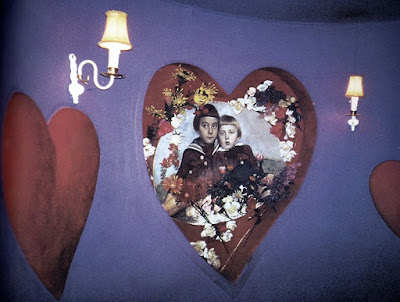
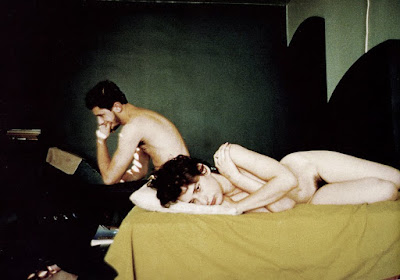
Pareja en la cama, Chicago, 1977: "Con frecuencia Goldin está presente en los momentos más íntimos de sus amigos más cercanos. Su confianza con ellos le permite captar y transmitir lo que en general suele mantenerse en privado: transgredir los tabúes sociales ha sido siempre una de sus preocupaciones. Esta instantánea parece expresar lo que Goldin percibe como el extrañamiento y la alienación que con frecuencia se producen entre hombres y mujeres tras el acto sexual. Aún dentro de la intimidad se da muchas veces un distanciamiento, paradoja que Goldin exploró con gran audacia en su obra más conocida, 'La Balada de la Dependiencia Sexual'."/"Often Goldin is present in the most intimate moments of her closest friends. Their confidence allow her to capture and convey what is usually kept in private generally: transgressing social taboos has always been one of her concerns. This snapshot seems Goldin expressing what she perceives as the estrangement and alienation that often occur between men and women after sex. Even within intimacy often happens a distancing, a paradox Goldin explored with great boldness in her most famous work, 'The Ballad of Sexual Dependency'."


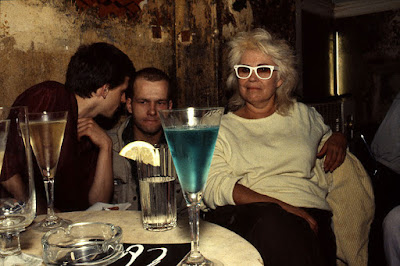


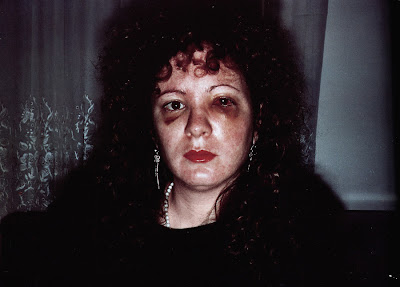
Nan un mes después de haber sido maltratada, Nueva York, 1984: "Esta fotografía muestra las consecuencias de la turbulenta relación entre Goldin y Brian, y constituye uno de sus retratos más despiadados. Siempre ha considerado esta obra una especie de aviso para no volver a caer en la misma trampa o para evitar teñir los recuerdos de nostalgia. Los golpes recibidos casi le costaron la vista del ojo izquierdo. En cuanto a su significado dentro de 'La Balada...', la obra simboliza el fin de un hermoso sueño y el inicio de una etapa de transformación completa."/"This photograph shows the consequences of the turbulent relationship between Goldin and Brian, and one of her more ruthless portraits. She has always considered this work a kind of warning to not to fall into the same trap or to avoid falling into nostalgia. The beatings almost cost her the sight in her left eye. As for its meaning in 'The Ballad ...', it symbolizes the end of a beautiful dream and the beginning of a stage of complete transformation."

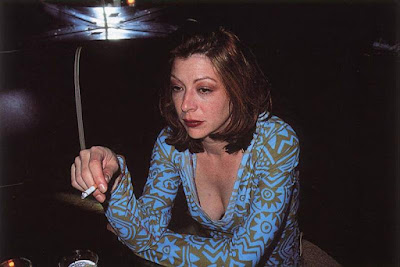
Kathleen en el Bar Bowery, Nueva York, 1995: "Kathleen, una artista neoyorquina, ha sido amiga íntima de Goldin desde finales de los 80s. Dentro de su serie de retratos femeninos, esta obra refleja un tipo de belleza de otra época llena de comprensión y sensibilidad. Es este equilibrio entre fortaleza y fragilidad que la ha convertido en un motivo frecuente en la obra de Goldin, quien ha intentado captar en esta imagen sus rasgos meláncolicos y su dulce sensualidad."/"Kathleen, a New York artist, has been a close friend of Goldin since the late 80s. In her series of portraits of women, this work reflects a kind of beauty from another era full of understanding and sensitivity. It is this balance between strength and fragility why she has become a frequent motif in the work of Goldin, who has tried to capture in this image her melancholic traits and sweet sensuality."
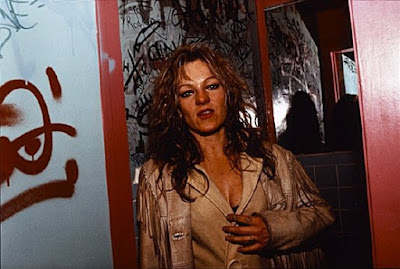
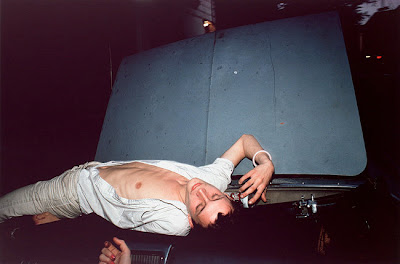
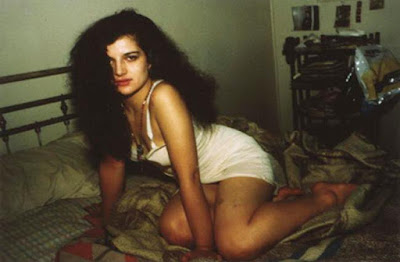

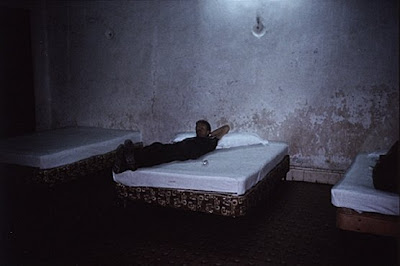
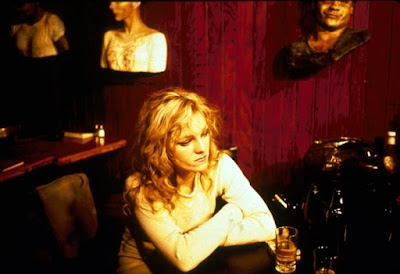
Cookie en el Tin Pan Alley, Nueva York, 1983: "Cookie Mueller, una actriz, poetisa y activista cultural del ambiente underground de Nueva York de principios de los ochenta, fue durante muchos años la mejor amiga de Nan, y tal vez incluso su musa y su gurú. Esta imagen pertenece al célebre portfolio de Cookie, en el que Nan cuenta la historia de su amiga desde que se conocieron en Provincetown en 1976 hasta su muerte por s.i.d.a. en Noviembre de 1989. En ella se ve a Cookie en el Tin Pan Alley, el club en el que trabajó Goldin durante cierto tiempo atendiendo la barra y donde con frecuencia presentaba sus primeras obras en forma de pases de diapositivas."/"Cookie Mueller, an actress, poet and cultural activist of the underground environment of New York in the early eighties, was for many years Nan's best friend, and maybe even her muse and her guru. This image belongs to the famous book of Cookie, in which Nan tells the story of her friend since they met in Provincetown in 1976 to her death from AIDS in November 1989. It shows Cookie in Tin Pan Alley, the club where Goldin worked for some time as a waitress and where she often show her work for the first time in the form of slideshows."




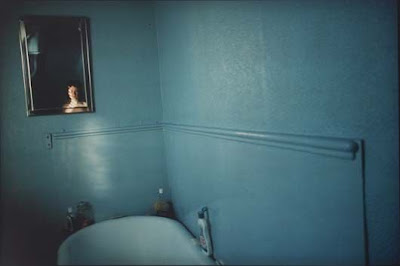
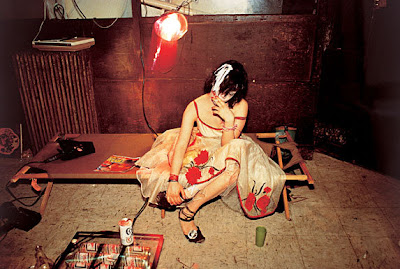
Trixie en el camastro, Nueva York, 1979: "Esta es sin lugar a dudas una de las fotografías más sugerentes entre las tomadas en fiestas y diseminadas a lo largo de 'La Balada...' como tema recurrente. El sentimiento de tristeza y de vacío en medio de una multitud, como inevitable contrapunto al fervor de una fiesta, es un signo identificador de la época, en que la sensación de alboroto de la vida en comunidad se mezcla con la consistencia del destino individual. Muchas de estas fotografías, incluso las más alegremente transgresoras, están impregnadas de una delicada melancolía."/"This is without doubt one of the most evocative photographs taken in a party and scattered throughout 'The Ballad ...' as a recurring theme. The feeling of sadness and emptiness in the midst of a crowd, as inevitable contrast to the fervor of a party, is an identifying sign of the times, in the sense of bustle of life in community is mixed with the consistency of the individual destination. Many of these photographs, even the most gleefully transgressive, are imbued with a delicate melancholy."
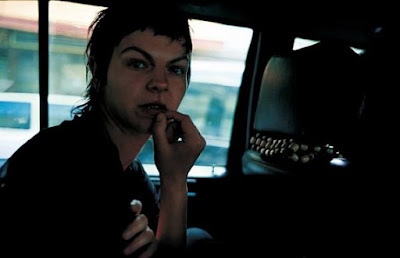




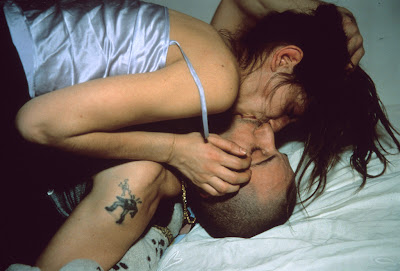


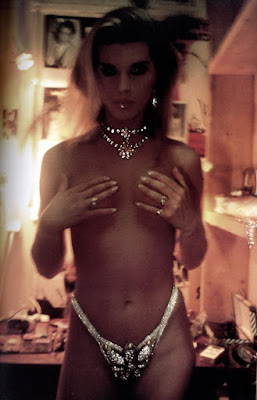
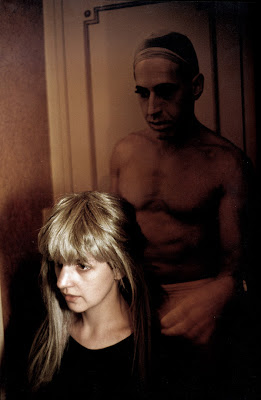
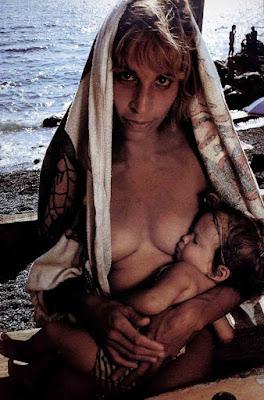

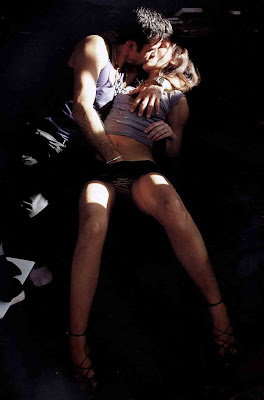
Joana Y Aurèle acariciándose en mi apartamento, Nueva York, 1999: "La sexualidad ha sido siempre un tema central en la obra de Goldin. Pero en esta fotografía más reciente de Aurèle y Joana, tomada en la casa de Nan en Nueva York, existe, a diferencia de otras obras similares como las de 'La Balada...', un planteamiento formal nunca visto hasta entonces. Todas las muestras de brutalidad han desaparecido (aunque aún siguen presentes en otras fotografías con el mismo tiempo), y han sido reemplazadas por un pusto de vista más romántico."/"Sexuality has always been a central theme in the work by Goldin. But in this more recent photograph with Joana and Aurèle, taken at Nan's house in New York, there is, unlike other similar works such as 'The Ballad...', a formal approach never seen before. All samples of brutality have disappeared (although still present in other photos of the same time) and have been replaced by a more romantic point of view."
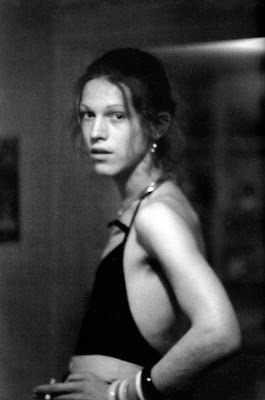
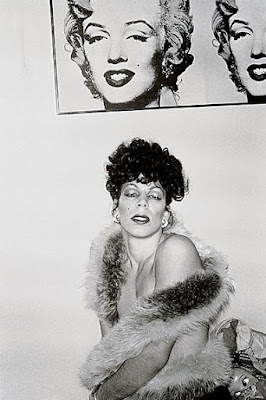
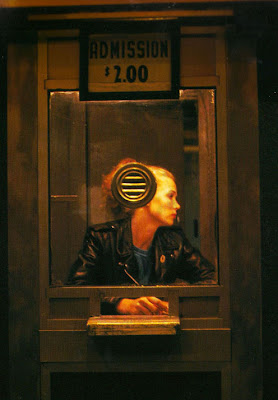
Foto fija deStill picture for 'Variety' (Bette Gordon 1983)

Foto fija deStill picture for 'Variety' (Bette Gordon 1983)
Nan Goldin es una conocida artista documental norteamericana inspirada en sus inicios por el ambiente de explosión sexual de los 70s, especialmente cuando comenzó a fotografiar conocidos que frecuentaba a partir de su trabajo como camarera o su residencia en el ambiente contracultural de Nueva York.
Nan Goldin is an internationally well known American documentary artist inspired initially by the explosive sexual atmosphere of the 70s, especially when she started photographing close people since her work as a waitress or her presence in a counterculture environment in New York.

[Pies de foto porFootnotes by Guido Costa parafor Phaidon]
EnlacesLinks
Gallery
artnet
Interview
YouTube
EscuchaListen
▶Radio Birdman·'Love Kills'
